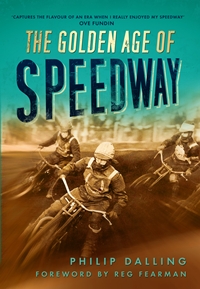
| |||||||
| |||||||
|
|
New Book:

When journalist and author Philip Dalling trawled through hundreds of magazines, newspapers, annuals, programmes and other items while researching his book on the speedway in Nottingham and Long Eaton, he was spellbound by the aura of the sport in the decade or so after World War Two. The result is a new book, The Golden Age of Speedway (The History Press), out now. Here he tells us about the new book and the era it covers.
Although speedway racing has experienced several periods of prosperity, few would argue against the claim that the sport's true golden age was recorded in the decade or so that followed the sport's post-war revival in 1946. The star quality and personality of riders like Jack Parker, Vic Duggan, Split Waterman and many, many others, the sheer size and enthusiasm of the crowds that thronged the stands and terraces at some of the UK's finest stadia, and a thriving three-division league structure which at one stage boasted nearly 40 tracks , all combined to give speedway a status in the sporting life of the country that it had never previously enjoyed and has never, at any subsequent date, entirely recaptured. Speedway in the late 1940s and even well into the 1950s, was truly an integral part of life in Great Britain. Delving into the archives, the researcher discovers that the sports journalists who were to become the undisputed stars of Fleet Street in the days of mass national newspaper circulations, mostly cut their teeth on reporting the sport. The sort of annuals that found their way into the Christmas stockings of most boys of the era, including that published annually by the famous and up-market Eagle comic, paid due homage to speedway. And the most famous academic social commentator of the 20th century, Richard Hoggart, declared that speedway riders were among the true working class heroes. Historians are notorious for every now and then publishing work which seeks to revise the popularly-accepted perception of events. One of the motivating factors behind The Golden Age of Speedway was my desire to re-examine some of the long-accepted beliefs about the sport in its heyday. The truly golden years of the late 1940s indeed saw a continual rise in both the number of tracks and attendances, which peaked at something around eleven million in 1949. Nevertheless, there was always an element of famine among the more general feasting. Some venues, particularly in the north of England, where economic recovery was slower than in the south and midlands, struggled to attract a paying crowd when other tracks were counting their attendances in tens of thousands. Even at the height of the boom, the sport was wracked by the sort of internal disputes familiar to present-day fans, over pay rates, foreign riders, safety and other issues, while there was no lack of voices forecasting decline long before it actually set in. The sport never achieved much in the way of official approval by the great and the good of British life. Although it survived an attempt by the post-war government to ban midweek sport, it fell foul of officialdom through the entertainment tax. The punitive rate of 48 per cent levied on speedway - quite astonishingly classed by bureaucrats as purely a trial of speed and not of skill - was far higher than that which had to be paid by football. Perhaps the most controversial aspect of my book is the inclusion within the description 'golden age' of the mid-1950s period, when speedway slumped from well over 30 tracks in three divisions to one single league of eleven teams. This was in 1957, after the pre-season withdrawal of Wembley, Birmingham and Poole. I have no doubts whatsoever that, despite the shrinkage in attendances and teams, this was still part of a golden age. The surviving teams, for the most part, continued to attract attendances unthinkable in Britain today for ordinary league fixtures. In addition (and this to me is a clinching argument), how could a period which saw the blossoming of the careers of young hopefuls like Ronnie Moore, Barry Briggs, Peter Craven and Ove Fundin into solid World Championship success, be anything but a Golden Age? Footnote: The Golden Age of Speedway has a foreword by Reg Fearman and a front cover recommendation by Ove Fundin. The story of the post war years is largely told through the eyes of the riders who were actually there. Each chapter covers a specific year, and has a profile of a rider for whom that year had a special significance. Philip Dalling's earlier book, Nottingham and Long Eaton Speedway 1928 - 1967, is currently being reprinted by The History Press

Buy 'The Golden Age of Speedway' from Amazon for only �11.49
This article was first published on 10th March 2011
" The golden years of speedway have always been for me the years addressed in in this artical, there are many reasons why this time was so. Just after the war crowds were enthusiastic and hungry for entertainment and there were riders who entertained them, real speedway artists, one of which was was my father Graham Warren. I look forward to reading the book. "
|
||||||
| Please leave your comments on this article (email address will not be published) | |||||||

